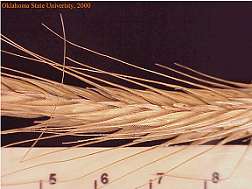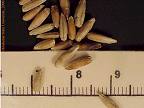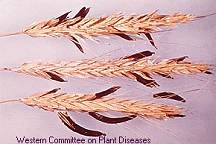Previous Page | Right click this page to print.
Rye
In the U.S., rye is a not an important cereal grain. Rye is the hardiest of the cereal grains. Rye is grown in regions with cold temperatures, poor quality soils, and short growing seasons.
Figure 4.19 illustrates the head of rye grain.

Figure 4.20 illustrates rye grain.

Table 4.7 summarizes the average nutrient composition of rye.
Nutrient |
Average Composition,
% |
|---|---|
Crude protein |
13.4 |
Ether extract |
1.8 |
Crude fiber |
2.6 |
Ash |
2.1 |
NFE |
80.1 |
Starch |
63.8 |
The nutrient composition of rye is similar to wheat. However when rye is fed, the production results are lower than expected for the given nutritional composition.
Rye has a number of deleterious factors. Although not conclusively proven, these factors may contribute to the inferior production. In rye, a significant deleterious factor is ergot infection.
Figure 4.21 illustrates ergot on a cereal grain.

Ergot alkaloids are produced by a fungus. The fungus replaces the kernel in the head of the grain. Signs exhibited by animals affected by ergot include gangrene, reduced reproduction efficiency, reduced gain and efficiency, and neurological disorders. Compared to wheat, rye is more susceptible to ergot. The grains are susceptible to ergot during the pollination period; the longer the pollination period, the greater opportunity for infection. Other deleterious factors include alkyl resorcinols, pectins, pectosans, and water-soluble glucan-like gums. Alkyl resorcinols are phenolic compounds. Rye and triticale have the highest concentrations of the compounds. The alkyl resorcinols reduce feed intake. As rumen microbial enzymes digest pectins and pectosans, these compounds primarily influence the monogastric species.
Rye is less palatable than the majority of the other cereal grains. As rye contains appetite and growth depressants for poultry, rye is not typically fed to poultry. Rye may be fed to young swine. Rye may be fed to cattle in limited amounts. The maximum amount fed varies by class of animal.
Previous Page | Right click this page to print.